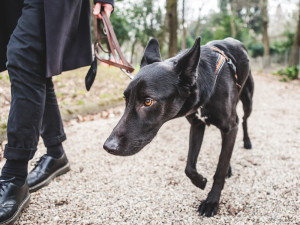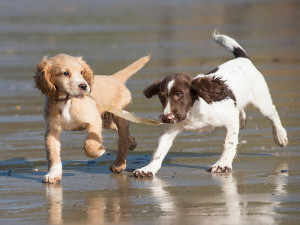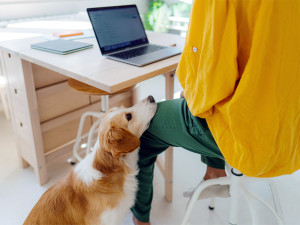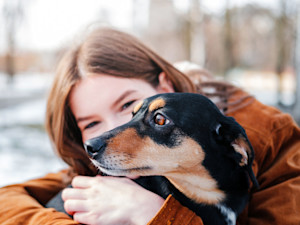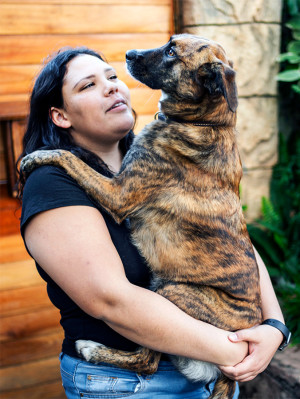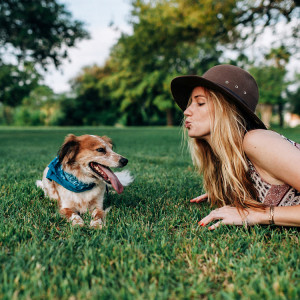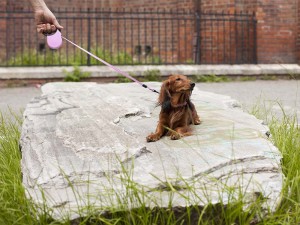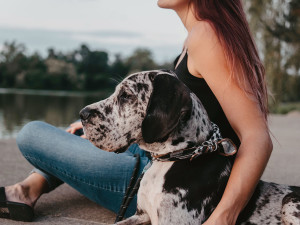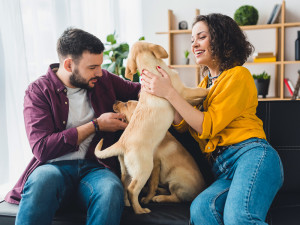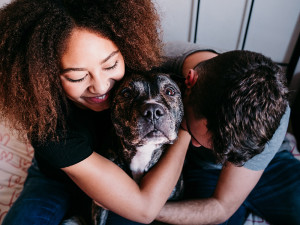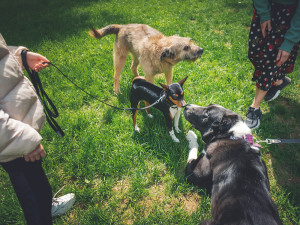School’s Back in Session—How to Deal if Your Dog Gets Overwhelmed by the Chaos
Noisy school buses and crowds of roving children can be scary for some pups.

Share Article
Whether Christian Girl Autumn is canceledopens in new tab or backopens in new tab (can’t keep up anymore honestly), fall is just around the corner. And with it come our emotional-support pumpkin spice lattes and all the oversized sweaters from our storage bins. We are ready. And while our dogs are mostly ready — nothing quite beats a crisp, cool walk outside — there is one thing in particular that isn’t so fun for them: kids going back to school.
This is not to say that dogs have any opposition to kids getting their education; they have more of an issue with the fact that many of them have to leave the house to do it. When gaggles of kids take to the streets with their backpacks, carpool pick-up lines, and shrieks of excitement, it’s fairly anxiety-inducing. Children, especially young children, are unpredictable, even if their parents tell them to respect the boundaries of the pups they meet. Thankfully, there are many things you can do to prep your nervous dog for the new school year (and the kiddos on the move).
We spoke with two certified trainers and a veterinary behaviorist to gather all the best techniques. Above all, our experts agree that it’s crucial to recognize and respect your dog as a sentient, autonomous being with feelings.
“Each dog has their own likes and dislikes as well as comfort levels,” says Stephanie Barger, dog trainer and owner of Canine Zenopens in new tab, which offers remote dog training throughout the United States. “They are not robots that just do whatever we say because we say it. You want to nurture your bond with your dog and help them to feel safe.”

What body language do dogs use to tell us they’re scared or uncomfortable?
We’ve all heard that a dog holding their tail between their legs is unhappy, but c anine body language is more complicated than that. Some dogs might wag their tails even when frightened. Watch how your dog carries their whole body instead.
Julia Albright, a veterinary behaviorist at the University of Tennessee, notes that many dogs will begin to show their anxiety through subtle avoidance behaviors. “You’ll see things, like lip-licking, yawning, turning the head away,” she says. If you’re walking your dog on a leash near a group of children, their behavior might escalate because they can’t get away. “That tail is going to go down and be tucked,” Albright says. “The whites of their eyes are going to show. Quite often, their ears go back. That can be easier to tell on some dogs than the other.”
Rayanne Cravenopens in new tab, a Mississippi-based trainer, notes that other signs of stress can include tight, closed lips; panting when it’s not warm outside; scanning the area and acting jumpy; crouching or walking low to the ground; and rejecting treats.
“It’s important to watch your dog and notice what their body language is when they are relaxed at home so you can be able to notice when they are stressed in places or situations,” Craven says. Some signs are more obvious — like pulling on the leash to escape, whining, barking, growling, or snapping.
According to Barger, dogs generally display more subtle signs of fear before they become aggressive or panic, but pet parents often overlook those early cues. Barger’s list of warning signs includes the eyes — hard versus soft stare, dilated pupils, exposed whites — as well as a stiff tail, sweaty paws, flexed toes, and stiff body movements.
How can pet parents train puppies to socialize with children and not be afraid of big crowds?
If you’re raising a puppy, make sure they get enough safe exposure to children and crowds during their prime socialization period to feel comfortable in the future. All three of our experts agree that these outings should be enriching but not overwhelming. “With puppies,” Craven says, “you want to make sure that every socialization experience they have is a positive one.”
According to the American Veterinary Medical Associationopens in new tab (AVMA), the prime socialization period for puppies runs from three to 14 weeks of age. Albright says this can last until 16 weeks. Gradually expose your puppy to the wider world in small, carefully moderated doses during this time.
Your puppy won’t be fully vaccinated until 20 weeks, so you’ll need to minimize any exposure to pathogens. “For example,” Barger suggests, “take your puppy out for a ‘walk’ while carrying them so that they can experience kids gathering at the bus stop while they are not fully vaccinated.” Along the way, your puppy will also get used to things like cars, bikes, skateboards, and buses.
Craven urges pet parents to start small with these adventures — like walking for five to 10 minutes at a distance from a big crowd or playground full of children. “Bring super tasty treats and even a chew toy and sit with your puppy rewarding them for just watching at a distance while they take treats from you or work on their chew toy,” she says.
This is where knowing your dog’s body language becomes vital. “If they want to move away, let them,” Craven says. “Over several sessions, you can move closer to the playground or large crowd, or if they are comfortable, even let them greet a child or two, but continue to keep the sessions short.”
Albright warns pet parents not to “flood” their dogs — meaning, put them in stressful situations for the sake of getting them used to it. Just because a dog is good with a familiar child or two at home, “don’t assume they’re going to be OK with five unfamiliar children running up to them at a bus stop.”
What do you do if your dog is already afraid of children?
Adjust your walking route and schedule to avoid children as much as possible. This will reduce your dog’s stress and therefore their anxiety. From there, you can begin working with a professional to boost their confidence.
“When looking for help with behavior modification, you want to find someone using positive reinforcement techniques and who go at the dog’s pace,” Barger says. “Behavior modification takes time and is not a linear process, so working with someone who not only knows this but can support you when things don't move as quickly as you would like is important to your long-term success.”
If your dog becomes comfortable enough to interact with children, coach the kids first on how best to approach. We should all seek consent before petting a dog, Albright says, ideally by standing five or 10 feet away and calling them over. Make sure kids know how to offer their affection as well. You don’t want to hover your hand above a dog’s head; instead, offer an open palm in front of them below chin level.
If your dog’s fear of children seems sudden, ask your veterinarian for a full workup and exam to rule out any potential medical concerns.
“I have heard of cases where the dog had a fear of children, either suddenly, or the fear had worsened, and come to find out there was a medical condition that was causing the dog pain and stress,” Craven says. Once any medical issues have been cleared, your dog might be more receptive to training.
How do you help adult dogs become better at dealing with large crowds?
We want our dogs to live full, happy lives, but this also means respecting their boundaries. Some dogs might never feel comfortable in these situations, and in those cases, our experts suggest that it’s likely better to let them stay at home where they feel safe.
Albright puts it simply: “When people say, ‘Can you train your dog to deal with crowds of people?’ the real answer is ‘Maybe, but should you?’”
If you and a professional determine that training would be beneficial, proceed slowly. Systematic desensitization uses positive reinforcement to help your dog progressively become more comfortable around triggers. This might mean learning to walk slightly closer to crowds or tolerate louder, more rambunctious children (or a greater number of children) nearby. Work with a professional to evaluate your dog’s body language and use reward-based training to establish positive associations with the things that make them uncomfortable.
Maybe you start by training in the same area as (but at a safe distance from) a calm child who is occupied with something else. Over time, Barger says, “you would then increase the activity level, the number of children involved or decrease the distance as your dog becomes more comfortable.”
You’ll want to keep these training sessions short and sweet, especially at first. Barger usually limits high-stress exercises to 15 to 20 minutes per day and often shorter. “You want to give your dog time to decompress before exposing them to the scary thing again,” she says. “So, some dogs need a day or two off between training sessions.”
During these training sessions, let your dog’s emotions set the pace. It’s up to us to show our dogs that we know how to keep them safe, and forcing them into situations where they feel unsafe might lead to aggression later on. Although it might be embarrassing to stand next to your dog while they bark endlessly on a leash, avoid the temptation to shut down their emotional responses. That, too, is important information.
How do you train fearful dogs to peacefully walk away from a crowd or avoid children during walks?
Before you work on training, make sure you’ve done everything you can to make walks peaceful. If your usual route goes past a school or bus stop, walk in a different direction and avoid pick-up and drop-off hours. If you see a cluster of kids approaching, cross the street or make a turn to distance yourself.
The more you limit your dog’s exposure to triggers, the easier your daily strolls will become. Still, occasional encounters are inevitable. In those moments, redirect your dog to something positive.
“It is usually possible to change your dog’s behavior if they are given enough distance from the thing that scares them and an alternative behavior to do that is rewarding to them,” Barger says. One technique is called nose-targeting — which means training your dog to “touch” a target (for example, an outstretched hand) with the tip of their nose.
Craven suggests trying out Control Unleashed Pattern Gamesopens in new tab from certified dog behavior consultant and author Leslie McDevitt. These games help distract dogs from perceived threats by giving them something more fun to do. Craven particularly likes the One-Two-Three Pattern Gameopens in new tab, in which you teach the dog that whenever you say “three” they get a treat. Little treats are crucial in life, and in this case, they can be the difference between a pleasant walk and utter chaos.
If you worry that your dog might bite someone, you might want to train them to become comfortable wearing a well-fitted muzzle. This will not only help prevent bites, Craven says, but also communicate to others (especially children) that your dog probably doesn’t want to be touched. Check out The Muzzle Up! Projec t for help with muzzle fitting opens in new tab and training.
What should you do if your dog bites a child?
None of us want to imagine that our dog could bite someone, let alone a child. Avoiding triggers and maintaining a safe distance should help to prevent any bad encounters. Still, accidents happen, and it’s important to take responsibility. If you don’t already know your local laws regarding dog bites, look them up to ensure that if a situation arises, you’ll be prepared. Also, make sure your dog is always up to date on vaccinations and required care.
If your dog bites someone, don’t get angry, Albright says. The damage is already done, and anger will only make the situation worse. Instead, focus on removing your dog from the situation as quickly as possible. Avoid removing your dog if they still have an active grip on the person they’ve injured, Barger warns. Pulling them away then could cause greater damage. Instead, wait for a moment, once their jaw has released.
Once you’ve established distance from the injured person, Craven suggests scattering treats on the ground at a safe distance from the child to calm and distract your dog. If that doesn’t work, try moving to a place where your dog cannot see the child. “Sometimes, going behind a car, garbage bin, or even into an alleyway can help break the visual contact for your dog and allow them to start calming down,” Craven says.
If another adult is not present, wait with the child (at a safe distance) until a caregiver arrives. If you’re alone, you might need to tether your dog away from the scared, injured person. Once an adult arrives, provide them your contact information in case they need to reach you later on.
“Don’t try to hide things,” Albright says. “Be open. Work with that family. Offer to pay the bills. But nothing good ever comes from trying to shirk responsibility.”
Above all, remember that every family has a different approach to teaching their children about how to interact with dogs, and some may not have done so at all. Not every child will understand the appropriate way to behave, so it’s your responsibility to set the necessary boundaries and work with your dog to keep everyone safe.

Laura Bradley
Laura is a New York-based experienced writer and mom of two rescue pups. Her work has appeared in Slate, Vanity Fair, Daily Beast, The Washington Post, The Atlantic, Yahoo! News, Vulture, Grazia Magazine, and more. When she is not writing or walking the pooches, you will probably find her in the community garden.
Related articles
![Dachshund dog freezing on a rock during a walk]()
Why Does My Dog Turn Into a Statue on Walks?
Suddenly, your neighborhood sidewalk has some new installation art: your frozen dog.
![A woman sitting with her arm around a dog enjoying a view of water.]()
How to Cure Your Dog’s Case of the Everyday Scaries
There’s nothing to fear but fear itself — and a dog who won’t stop shaking when it thunders.
![Smiling couple sitting on sofa with two playful labrador puppies.]()
There Is More Than One “Right” Way to Socialize Your Puppy
Take it slow. This process should never feel like speed-dating.
![A dog looking up with a cute face]()
How to Get Your Scared Dog to Trust You
Using these tips, your skittish dog will warm up to you.
![Couple hugs their merle Boxer]()
How to Improve Your Relationship with Your Dog
Animal behaviorist Dr. Karen B. London on how to strengthen your pet-parent bond.
![Three dogs on leashes meeting and sniffing each other on a walk on the summer grass with owners]()
How Do I Get My Shy Dog To Socialize?
Kinship Collective dog trainer Robert Haussmann’s tips for getting a shy pup to go from wallflower to social butterfly.

